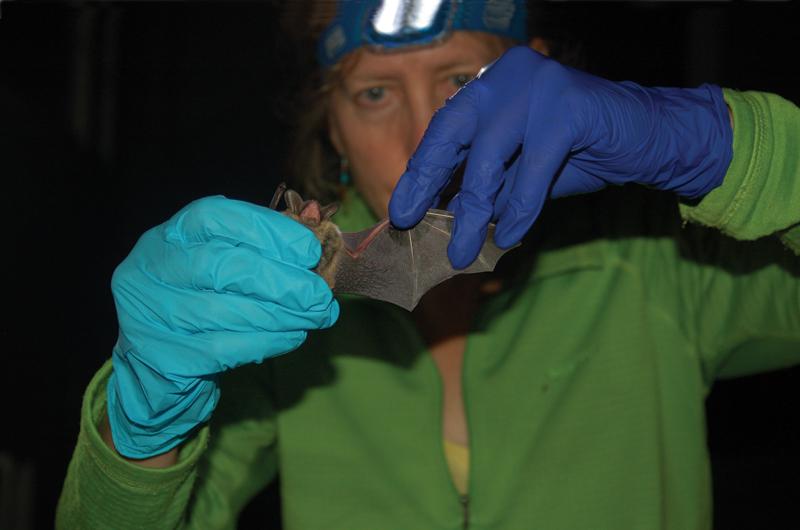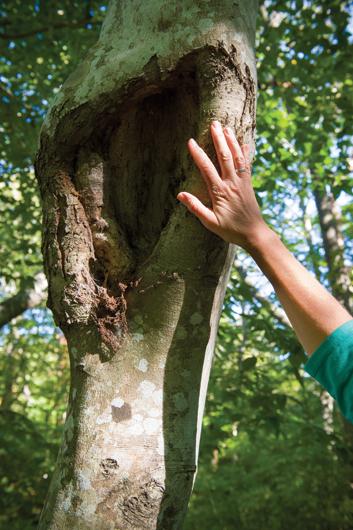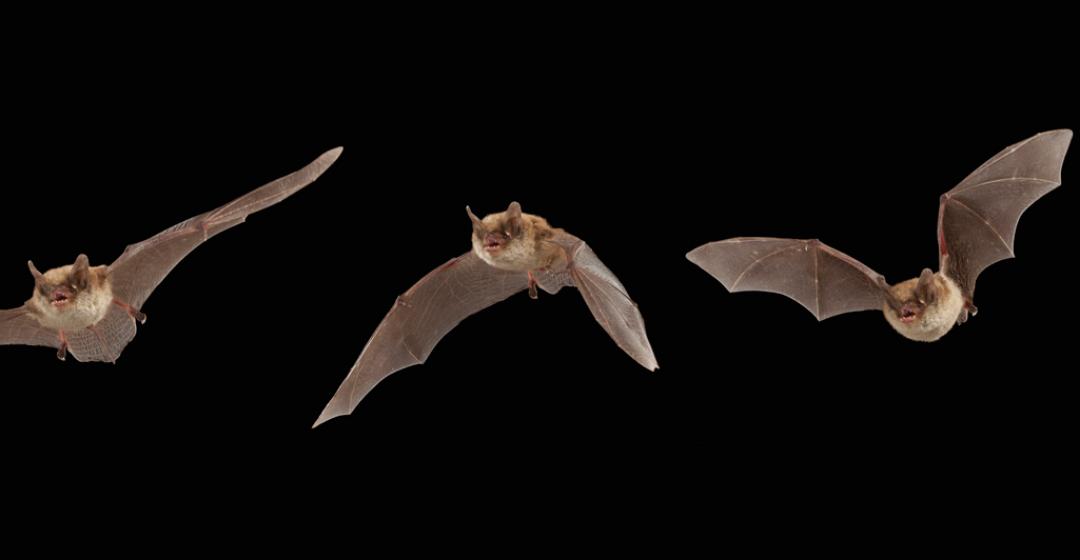When night settles on the Vineyard, the fields and forests come alive. Skunks and deer make their way across the Island (although they may not make it across the roads), while white-footed mice burrow through leaf litter, and may end up nesting in your car engine. Undeterred by the dark, screech owls swoop silently to catch their next meal, perhaps a field mouse or one of the seven snake species that inhabit the Island.
And there are bats, no one knows how many, each one consuming hundreds or thousands of insects before dawn. There are big and little brown bats (true to their names), and tiny northern long-eared bats, along with the hamster-like eastern red bats and other species that migrate south for the winter.
Much about the habits of Vineyard bats remains a mystery, but this summer and fall, a small group of Island researchers will be watching the Island’s northern long-eared bats closely in an effort to discover what has kept them relatively safe from a disease that has wiped out the species on the mainland. Some of the bats will end up in delicate mist-nets, to be untangled and tagged with radio transmitters. Once released, they can be followed back to their roosting sites in trees and houses around the Island.
“Everyone assumed that the northerns had died here just like they had died everywhere else,” said Luanne Johnson, director of BiodiversityWorks, which is leading the study. She was seated in her small office in the woods off Lambert’s Cove Road, surrounded by books, documents, and bat-tracking equipment. “Each summer that you are still having them and no one else does is an indication that you have a population that’s surviving.”
Since 2006, nearly all of the northern long-eared bats in the Northeast have succumbed to white-nose syndrome, which shakes them out of hibernation, causing them to burn critical energy and die before the winter is through. The decline was sudden, as the cold-loving fungus Pseudogymnoascus destructans, which causes the disease, spread across the eastern half of the U.S. and five Canadian provinces. Northern long-eared and other hibernating bats encounter it in caves and mines, where it colonizes their noses and other exposed body parts during hibernation. Most bats have an ability to regenerate wing tissue damaged by the fungus in a matter of weeks, giving them a fighting chance against the disease. But for those infected early in the season, the outlook is grim. More than 90 percent of infected bats don’t make it through the winter.

“It’s mind-boggling, the mortality factors,” said Gus Ben David, a well-known Island naturalist who has noticed at least one northern long-eared bat roosting on his Edgartown property during the summer season. “They have always been here; we know that,” he said. “They were part of the flora and fauna that people just took for granted, but there were never any studies done.”
For those who care about the survival of the species, it is therefore heartening news that even though the Island’s population of little browns has appeared to decline (in keeping with off-Island trends), the Vineyard has one of the last breeding populations of northern long-eared bats in the Northeast. Research on the Island began in the late 1990s when Kendra Buresch, a graduate student at the University of New Hampshire, spent two years studying migration and habitat use in the region. While scientists on the mainland were catching mostly little brown bats, Buresch’s work suggested a much more abundant population of northern long-eared bats on the Vineyard.
Around 2013, after white-nose syndrome had decimated off-Island populations of northern long-eared bats, the Nature Conservancy found roosting females in their bird boxes at the Hoft Farm in Vineyard Haven. They sent photos to the U.S. Fish and Wildlife Service. At the request of state and federal agencies, BiodiversityWorks set up acoustic detectors and confirmed the presence of northern long-eared bats at several locations on the Island. The following year they set up mist-nets and captured breeding females in Vineyard Haven, West Tisbury, and Chilmark. Then in 2015, with funding from the Martha’s Vineyard Vision Fellowship, they documented a juvenile roosting in a deck umbrella in Aquinnah.
Johnson and assistant director Liz Baldwin had plenty of experience with birds when the project began, but bats were a new challenge. With their delicate elbows, wrists, and claws, they can be harder to untangle from the nets. And unlike birds, they have teeth and may carry rabies, although the chances are small. Researchers are vaccinated and wear protective gloves. The bites themselves are relatively minor, though.
“You can’t really feel it, they just sort of gnaw on your finger,” Baldwin said. “But a red bat and big brown, they can draw blood.” In handling the northern long-eared bats, Johnson learned, among other things, to blow through a metal straw in order to part their hair and see if they were lactating. The bats are usually released onto a nearby tree, where they scamper away and reorient themselves before taking off.
Johnson and Baldwin have embarked on the first scientific study of any bats on the Vineyard since Buresch’s pioneering research in the 1990s. “That’s one of the reasons why I started BiodiversityWorks,” Johnson said of the scarcity of solid ecological data on the Island. “Martha’s Vineyard is a great community of naturalists, but there is not that much published.” Almost all bat research focuses on caves, which partly explains the lack of information on the Island. And until recently, northern long-eared bats were so abundant in North America that funding typically went elsewhere. The Mammals of Martha’s Vineyard, published in 1969, mentions little brown and eastern red bats as common to the Vineyard. Big brown bats, northern long-eared bats, and five others were listed in Island Life, the first comprehensive species list for the Vineyard, in 2008.

Caves are where many bats contract the disease, and Johnson hypothesizes that little brown bats, perhaps unlike northern long-eared bats, hibernate off-Island, where they encounter white-nose syndrome. That could explain the apparent decline of brown bats on the Vineyard in recent years. Twenty years ago Buresch found bats in every Island habitat, although most were captured in the up-Island woodlands, which are wetter with more insects. By contrast today, said Johnson, “They are very hard to find.”
Some species, including red bats, hoary bats, and silver-haired bats, migrate south for the winter and are therefore less exposed to the disease. But no one can say for sure why the northern long-eared bats survived. Many speculate that the Island population of northern long-eared bats is surviving by overwintering in houses, rather than caves and mines, which by all accounts don’t exist on the Vineyard.
“They don’t have those damp, wet, cold conditions that would harbor the fungus,” Ben David said of the typical barn or basement where the bats might be overwintering.
But nobody has actually seen bats in hibernation on the Island. “The burning question for us,” said Johnson, “is what do the winter hibernacula look like on Martha’s Vineyard? How many are there? And how many bats are in those? Is it just a few northerns all over the Island in small groups, or is there one main group?”
Work continued last year, this time with the aid of nanotags, each about the size of a black bean, which researchers attach with an eyelash adhesive. Temporary radio towers were set up near Lambert’s Cove, and BiodiversityWorks followed eleven bats to a large number of roosting sites, including twenty-four around Lambert’s Cove Road. With continued funding from the Martha’s Vineyard Vision Fellowship, three radio towers went up again this year, including one on Naushon, keeping watch over fields and forests, but also Vineyard Sound, in case any of the bats leave the Island.
“We found a good maternity colony and they seem to be having pups and doing well,” Johnson said of the progress. Most notably, the team was shocked to find bats roosting not only in dead trees but in people’s houses. “Everybody told us they used roost trees,” she said. “And then our female bats were raising their pups underneath the outside trim boards of people’s houses. That was pretty exciting.”
It’s hard not to marvel at bats in flight, which is where they do their feeding. All insect-eating bats use echolocation to find their prey, sending out tiny chirps and sensing the echoes. When amplified by special equipment, the calls may sound like a small bird, or for some larger species, a sort of kissing noise. As they hone in on their prey, the tempo increases, creating what researchers call a feeding buzz. “The closer and closer together they make the calls, the more accurate the picture they have of smaller things that are around them,” Buresch said. “They can even tell what shape it is.” It all ends with a flick of the wings, as the bat knocks the prey into its tail membrane and brings it to its jaws.
Northern long-eared bats prefer cluttered forests, where they eat all sorts of insects, providing a valuable service to both the ecosystem and human environments. Some people have reported an uptick in mosquitoes in areas where bats have declined. And Baldwin speculates that the loss of bats due to white-nose syndrome may have opened the door to gall wasps, winter moths, and other pests on the Island. “We’ve had all these outbreaks of oak-eating insects that are decimating all these trees,” she said. “When did that outbreak start happening versus when we had this big decline in bats?”
One theory is that it’s only a matter of time before the Vineyard’s northern long-eared bats disappear along with the others. But Johnson believes they could be outliers, hibernating in smaller groups in basements and cisterns around the Island. “We just haven’t figured out where that is,” she said. Those spaces would likely be too small to attract migratory bats, which would keep them free of the fungus to begin with. The damp coastal environment may also play a role, since it could broaden the options for hibernating bats. Farther inland, the argument goes, the lower relative humidity limits them to caves and mines, and encourages larger colonies.
“Let’s say they overwintered in somebody’s cinder-block basement that had bulkhead doors,” Johnson said. “It’s a perfect scenario: no heat, below ground, cool, damp.” And if the basements were unfinished, she added, the bats could even crawl into the walls. “You would never know they were there.”
One obstacle to finding colonies on the Island in the dead of winter is that the nanotags tend to stop working after about twenty-one days, or fall off much sooner. When a northern long-eared bat turned up in a bird box near Ben David’s house, BiodiversityWorks tagged it, although they knew it would likely not solve the hibernation mystery. They followed it for nineteen days, until the tag fell off in October. Last year, the bats were tagged mostly in the summer, so the researchers weren’t able to follow them to their hibernation sites in the fall. This year they plan to tag later, although the bats get harder to find once the weather cools.
Without direct observation, researchers can’t say for sure where the species is hibernating, but the trail is getting warmer. In February, for example, a northern long-eared bat was uncovered beneath the rake board of a house on Chappa-quiddick. “It’s likely that bat came out of a hibernaculum for a few days while the weather was warm and then went right back into it,” said Johnson. “But we don’t know where that was.” Based on a photograph, she said the bat did not appear to have white-nose syndrome. Others last winter reported bats flying around in Chilmark in the evening before the weather cooled again.
In October, the bats will begin settling down for the winter, and BiodiversityWorks will again be watching. Johnson hopes that at least one of the nanotags will hold fast through the fall and lead to a hibernaculum. As a rule, the researchers also ask that anyone who finds a bat will let them know. “Reporting that they have a bat in their basement in the winter is so exciting for us,” Baldwin said. “And really, I feel like that’s how we are going to answer this question of where these bats are overwintering.”




 1 comment
1 comment
Comments (1)